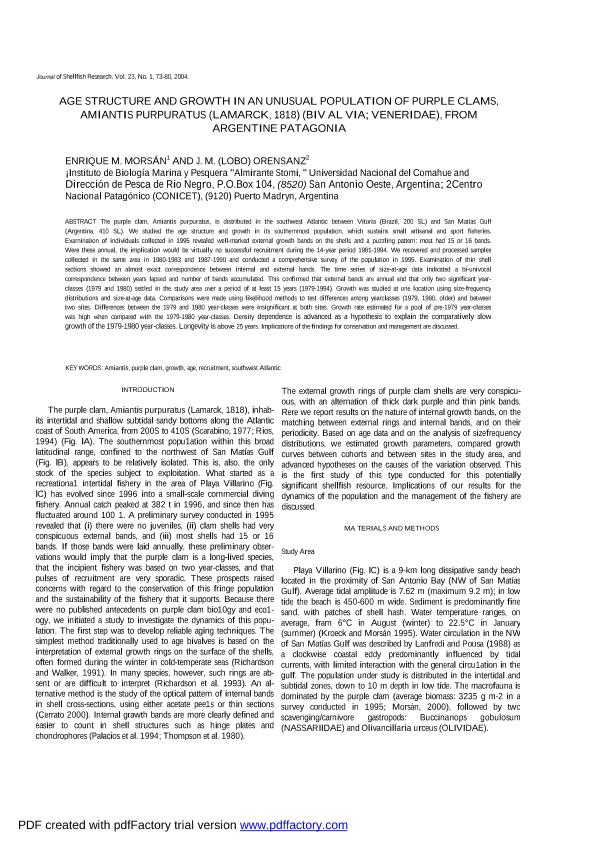Mostrar el registro sencillo del ítem
dc.contributor.author
Morsan, Enrique Mario

dc.contributor.author
Orensanz, Jose Maria

dc.date.available
2020-05-05T20:57:48Z
dc.date.issued
2004-12
dc.identifier.citation
Morsan, Enrique Mario; Orensanz, Jose Maria; Age structure and growth in an unusual population of purple clams, Amiantis purpuratus (Lamarck, 1818) (Bivalvia; Veneridae), from Argentine Patagonia; National Shellfisheries Association; Journal Of Shellfish Research; 23; 1; 12-2004; 73-80
dc.identifier.issn
0730-8000
dc.identifier.uri
http://hdl.handle.net/11336/104307
dc.description.abstract
The purple clam, Amiantis purpuratus, is distributed in the southwest Atlantic between Vitoria (Brazil, 20º SL) and San Matías Gulf (Argentina, 41º SL). We studied the age structure and growth in its southernmost population, which sustains small artisanal and sport fisheries. Examination of individuals collected in 1995 revealed well marked external growth bands on the shells, and a puzzling pattern: most had 15 or 16 bands. Were these annual, the implication would be virtually no successful recruitment during the 14-year period 1981-1994. We recovered and processed samples collected in the same area in 1980-1983 and 1987-1990, and conducted a comprehensive survey of the population in 1995. Examination of thin shell sections showed an almost exact correspondence between internal and external bands. The time series of size-at-age data indicated a bi-univocal correspondence between years lapsed and number of bands accumulated. This confirmed that external bands are annual, and that only two significant year-classes (1979 and 1980) settled in the study area over a period of at least 15 years (1979-1994). Growth was studied at one location using size frequency distributions and size-at-age data. Comparisons were made using likelihood methods to test differences among year-classes (1979, 1980, older) and between two sites. Differences between the 1979 and 1980 year-classes were insignificant at both sites. Growth rate estimated for a pool of pre-1979 year-classes was high when compared to the 1979-1980 year-classes. Density-dependence is advanced as a hypothesis to explain the comparatively slow growth of the 1979-1980 year-classes. Longevity is above 25 years. Implications of the findings for conservation and management are discussed.
dc.format
application/pdf
dc.language.iso
eng
dc.publisher
National Shellfisheries Association

dc.rights
info:eu-repo/semantics/openAccess
dc.rights.uri
https://creativecommons.org/licenses/by-nc-sa/2.5/ar/
dc.subject
PURPLE CLAM
dc.subject
GROWTH
dc.subject
AGEING
dc.subject
POPULATION STRUCTURE
dc.subject.classification
Otros Tópicos Biológicos

dc.subject.classification
Ciencias Biológicas

dc.subject.classification
CIENCIAS NATURALES Y EXACTAS

dc.title
Age structure and growth in an unusual population of purple clams, Amiantis purpuratus (Lamarck, 1818) (Bivalvia; Veneridae), from Argentine Patagonia
dc.type
info:eu-repo/semantics/article
dc.type
info:ar-repo/semantics/artículo
dc.type
info:eu-repo/semantics/publishedVersion
dc.date.updated
2020-04-27T14:43:42Z
dc.journal.volume
23
dc.journal.number
1
dc.journal.pagination
73-80
dc.journal.pais
Estados Unidos

dc.description.fil
Fil: Morsan, Enrique Mario. Universidad Nacional del Comahue. Instituto de Biología Marina y Pesquera Almirante Storni; Argentina. Consejo Nacional de Investigaciones Científicas y Técnicas; Argentina
dc.description.fil
Fil: Orensanz, Jose Maria. Consejo Nacional de Investigaciones Científicas y Técnicas. Centro Científico Tecnológico Conicet - Centro Nacional Patagónico; Argentina
dc.journal.title
Journal Of Shellfish Research

dc.relation.alternativeid
info:eu-repo/semantics/altIdentifier/url/https://bioone.org/journals/journal-of-shellfish-research
Archivos asociados
